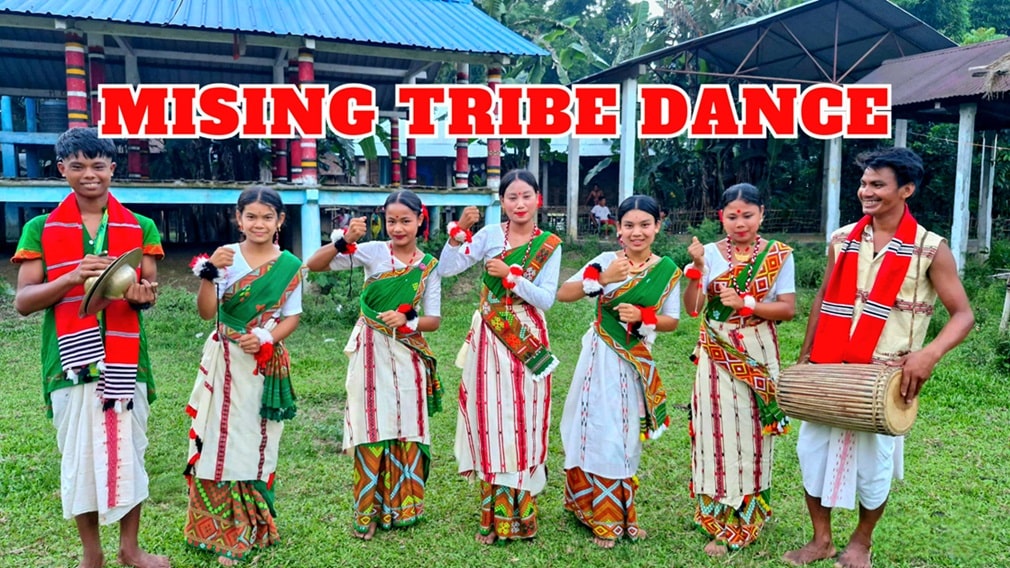I have lived for two months with the second-largest tribe of Assam, India – the Mising Tribe on world’s largest river island – Majuli. Their lifestyle is in sync with nature. I have closely observed their daily routines and way of life. Today, I will share some of my experiences while living with this tribe on Majuli Island.
Bamboo Houses of Mising Tribe
For two months, I stayed in a traditional bamboo house
known as a Chang Ghar. My house was around five feet above the ground to protect it from the annual floods. All the houses here are built similarly, approximately 5–6 feet above the ground. Even the new houses made of bricks and cement are elevated to protect them from regular flooding.
The Mising Tribe has been living near the Brahmaputra River for centuries, ever since they migrated from the mountains to the plains. Almost every year, they face floods, which is why their houses are elevated. Even their temples, community meeting spaces, and function halls are built from bamboo and are raised above the ground.

Nowadays, most houses have cement pillars, but if you look at some of the older homes, you’ll find that even the pillars are made of bamboo or wood. The stairs to reach these houses are also different from regular ones. I saw various types of stairs: some made from coconut wood or tree trunks cut in half to form steps, some resembling traditional wooden stairs, and in a few houses, even modern wooden or cemented staircases. Most of the beds and furniture are also made from bamboo and wood.
Their kitchens have stoves made from clay or soil, similar to traditional clay stoves found in Indian villages, though slightly different in design. Almost every house here has its own personal boat, which is used for fishing and also during floods.
What Mising Tribe Eat?
Okay!!!
So, I have been a pure vegetarian since birth, while the Mising Tribe is non-vegetarian and consumes almost all animals except cows (they consider cows sacred as they are Hindus). They also do not eat horses. Despite that, there were plenty of vegetarian options available. They eat a lot of leafy vegetables — in fact, they also consume the banana stem, small branches of the cotton tree, papaya leaves, and many such items. Some of these are even eaten raw, without cooking.
They do not eat roti or chapati as part of their regular meals. Instead, they eat rice for breakfast, lunch, and dinner. I tried all the vegetarian dishes, and they were good. However, most of the time, they cook non-vegetarian meals, which was a big problem for me since I don’t eat non-veg food or consume that much rice. Somehow, I managed to survive for two months, though my health was affected during that time.
Another famous item here is rice beer. You’ll find a shop selling rice beer every few steps. People also make it at home. It is an essential part of every function and festival. From children to elderly people, everyone drinks rice beer regularly.

Tradition, Culture and Festivals
The Mising Tribe follows Hinduism, but they also observe their own traditional rituals and worship deities like Doni-Polo (Sun and Moon). They perform rituals for agriculture, healing, and during major life events such as birth, death, and marriage.
I was there during May and June, by which time most of the festivals had already passed. I couldn’t attend any weddings either — only one marriage took place during my stay, and that too within my first two or three days in Majuli.
Their most important festivals are Ali Aye Ligang and Ras Mahotsav, where they perform their traditional dances and sing folk songs. However, the Mising people were kind enough to perform their traditional dance Gumraag especially for me. They wore their traditional attire, explained it to me, and showcased their beautiful cultural dance. You can watch there Gumraag dance here. There marriages are very unique I will tell you about that in our next blog. I have also made a vlog while living with the tribe, you can watch it here.
Now, I am continuing my journey from the Mising Tribe to another tribe closely related to them. Can you guess the tribe? (Hint: I’m heading to Arunachal Pradesh!)
To know more, hit the subscribe button and wait for the next story.
Until next time, keep traveling and take care of nature.
Pingback: Marriages in Mising Tribe: a unique Tribal Marriage - Shruti's Fairytales